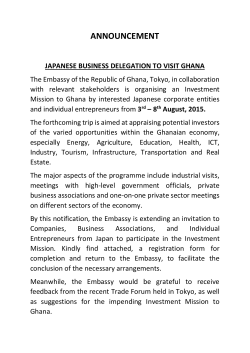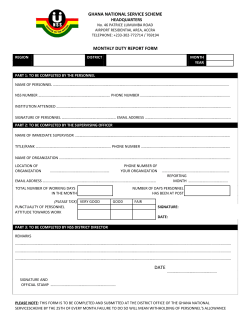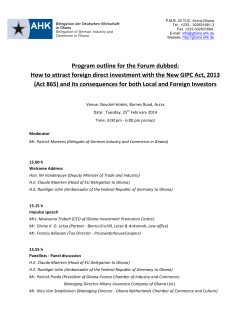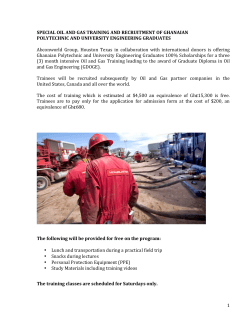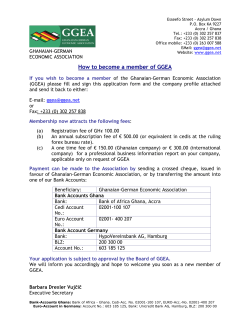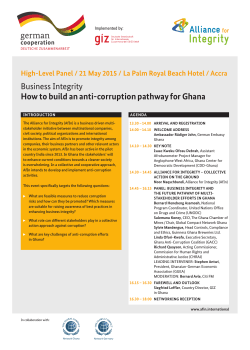
IMPROVING GHANA`S GEODETIC REFERENCE NETWORK FOR SOCIO
IMPROVING GHANA’S GEODETIC REFERENCE NETWORK FOR SOCIOECONOMIC DEVELOPMENT Yaw Poku-Gyamfi CSIR-BRRI Outline • • • • • • Ghana Geodetic Survey before the GRN Why the GRN Establishing the GRN (Phase 1) The benefits Future of the GRN (Phase 2) Socio-Economic Benefits History of Ghana’s Geodesy • Field-Astronomy observations by F.G Guggisberg in Accra in June 1904, observation of 15 stars • Nov-Dec 1904, exchange of telegraphic signals from Cape Town to determine our Longitude • Connected to Leigon datum GCS 547 • Ellipsoid of reference was the War Office 1926 Ellipsoid • In 1977 Ghana attempted using the Clarke 1880 Ellipsoid in order to join most African countries but the result was not put into the public domain although we have some monuments in this ellipsoid in the system CLASSICAL REFERENCE SYSTEMS • Ghana used the War Office (1926) and Clarke 1880 (Ghana modified) Ellipsoids • Parameters defining these ellipsoids were realized using Classical Geodesy, star observation, derivation of longitude using telegraphic signals etc. • Unique parameters for most countries • Committee on Development Infrastructure (CODI) in July 1999 stated that: ‘National governments are requested to transform their respective national datums to the worldwide WGS84 and International Reference System (ITRS) including the determination of the geoid’. ([2] Establishing a Continental Reference System in Africa – AFREF, March 2002, Proposal to ICSU) • LAP’s decision to establish ITRF in Ghana is therefore a step in the right direction LOCAL AND GLOBAL ELLIPSOIDS Local Ellipsoid Global Ellipsoid A Unified Continental Geodetic Reference Frame (AFREF) Why GRN (1) • Move away from the classical geodesy to satellite geodesy • To utilize the GNSS signal from space which keeps on improving with the modernizations • Improvement of receiver technology and the downward trend of the cost • To join the global community in a common reference system to enhance cross-border land related activities by using the international Reference frames Why GRN (2) • Confusion in using a system running on two ellipsoids as a country • Will not need any rigorous mathematical transformations when using the Global Navigation Satellite Systems (GNSS) • To enhance Land Administration and delivery as a nation • To benefit from the ever increasing applications of GNSS. International Terrestrial Reference System (ITRS) • ITRS is on the contrary is gaining popularity due to its consistent improvement with the increase in the number and quality of the input observations, processing methods. • This global geocentric coordinate system is very similar to WGS84 of GPS, the GTRF of the future Galileo and the other GNSS‘s. IMPLEMENTING GRN • Monumentation • Observation • Data Processing – Long Baselines – Short Baselines – Satellite Stations • Network Adjustment Composition of the GRN • Continuously Operating Reference Stations (CORS) • Second Order Control Stations • Control Center GRN (Phase 1) Coverage • Covers the Golden Triangle of Ghana • Three Permanent Stations located in Accra, Kumasi and Takoradi • Two Hub Stations at Kade and Assin Fosu • Fifteen New Reference Stations distrubuted within and around the GT • Additional CORS at Bolgatanga, Tamale, Savelugu, Donkorkrom and Winneba • Nationwide GNSS Reference Network Design for Ghana – 23.03.2015 Phase 1 13 GRN Data Processing Establishment of Geocentric Coordinates • Long Baseline Processing – Selection of IGS Stations • Maspalomas (MAS1), Spain and N‘Kolatang Libreville Gabon (nklg) – Data processing • GTCE module of the PrePos GNSS Suite was used as the Scientific Software • Considerations – Station velocity, Antenna Eccentricity, Ocean Loading, Solid Earth Tides, Satellite Eccentricity, Tropospheric Kalman Filter etc Some IGS Stations in Africa GRN Data Processing – Short Baseline • Short Baseline Processing (Reference Stn, tightly constraining the PS and HS) – SEMIKA module of PrePos GNSS Suite • Atmospheric correction (Iono and Tropo), cycle slip detection and repair, satellite eccentricity iono-free LC, Klobuchar model for Iono correction. Interactive optimization using 3D viewer New stations • Area covered with in Phase 1 of the GRN 2.9 Datum Transformations Geodetic datum Minimum set of parameters required to define location and orientation of the local system with respect to the global reference system/frame 09/00 Y' Z' εz εY b Datum Transformation Translation of the origin ∆X, ∆Y, ∆Z Rotation angles εX, εY , εZ Scale factor µ Change in ellipsoid ∆a, ∆f Z a εX X X' Y DGPS Concept • Requires 2 receivers a base and a rover • Base located on an known point • The set of receivers track the same satellite vehicles at the same epoch • Error at the base station is computed and corrected w.r.t. the known coordinates • This correction is used to correct the biased observation of the rover Assumption: • Within a limited base length, the correction is considered identical Drawback: • The distance of the rover to the base is usually less than 10 km, and is even worse in low latitude and tropical country like Ghana 23.03.2015 19 DGPS Concept Problem Accuracy of single GNSS station for many purposes inadequate Remedy • Certain GPS error components are similar for users not separated • The error components are slowly varying with time • Usually, the coordinates of the reference station are precisely known • Total measurement error at the reference station can be determined for each satellite • Taking the measured errors into account leads to an improvement in accuracy for the user station • Effective quality control by monitor stations feasible Improved Solution: The use of a reference network 23.03.2015 20 Network RTK concepts GRN Phase 2 • Phase 2 of the GRN will include – Covering the whole of Ghana with CORS at relatively shorter inter station distances (More that 50 stations have been proposed) – Some selected areas in the country will have Active network (Network RTK) Reference Station Networks Idea: Sufficient coverage of reference stations for a whole country Benefit: User will no longer need two GPS receivers, but take advantage of a common reference station Situation: S3 Rover S2 S1 Problem: Due to their different corrections user will get different navigation results! Solution: Network RTK concepts (FKP, MAC and VRS) 23.03.2015 22 FKP and VRS Area Network Corrections (FKP) • Linear error description using a number of reference stations • Correction for every site within the net provided Virtual Reference Station (VRS) • All reference stations of a network are connected to a server • providing a database of regional corrections • User sends a approximated position (generated by code • measurements) to the server • Correction values are derived for approximate position Assessment VRS more accuracte, but requires a bi-directional communication 23.03.2015 23 Expected Socio-Economic Benefits Thank You
© Copyright 2025

